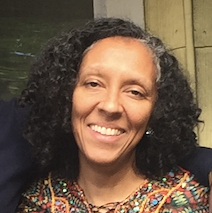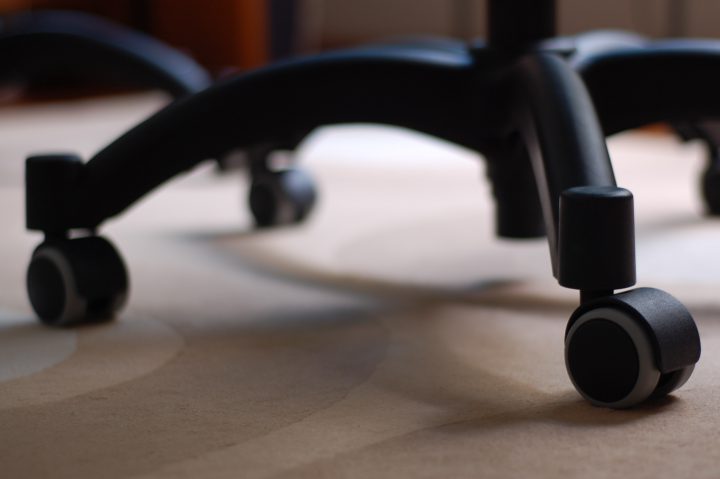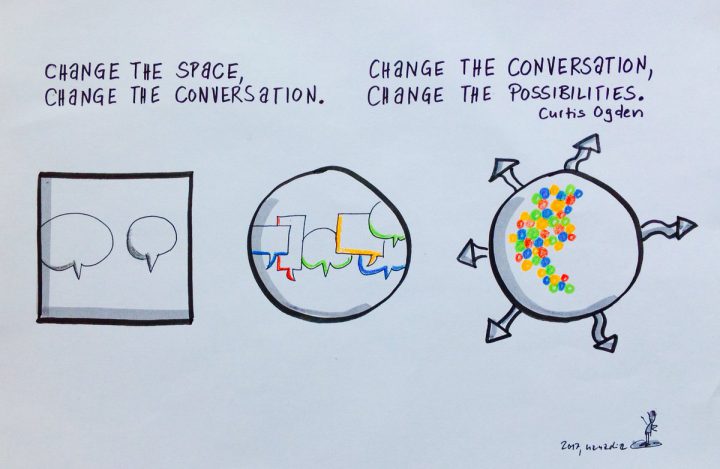Archives
October 2, 2017
“We cannot live for ourselves alone. Our lives are connected by a thousand invisible threads, and along those sympathetic fibers, our actions run as causes and return to us as results.”
– Herman Melville
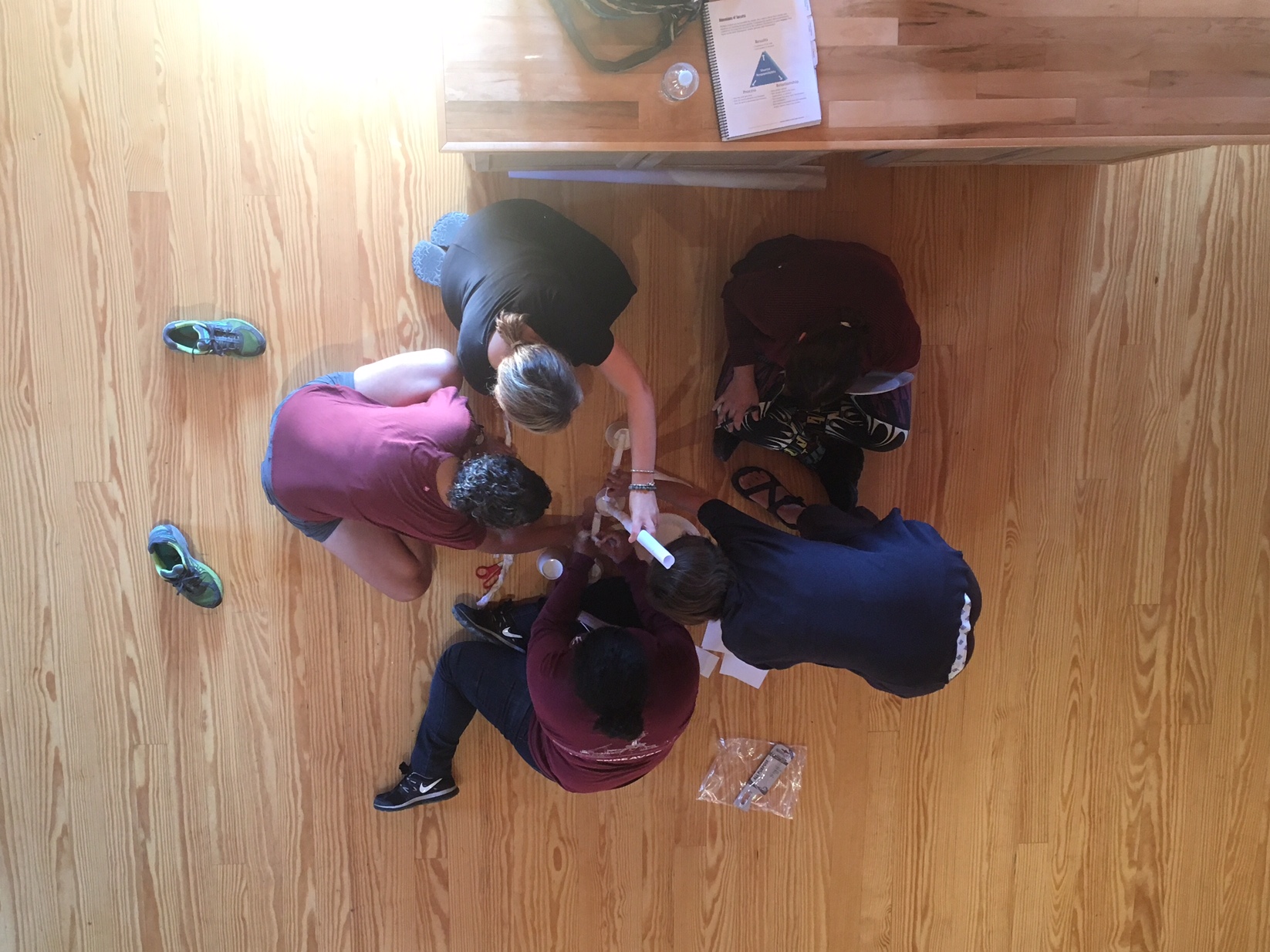
2017-2018 NLI cohort members engage in a team building exercise focused on the dimensions of collaborative success.
Last week I worked with the Backbone Team of Food Solutions New England to launch the second cohort of the Network Leadership Institute (NLI) at Ohana Camp in Fairlee, Vermont. This initiative has grown out of FSNE’s commitment to cultivating both thought leadership and network leadership “to support the emergence and viability of a New England food system that is a driver of healthy food for all, racial equity, sustainable farming and fishing, and thriving communities.” Another impetus for the NLI was a year spent doing system mapping and analysis that revealed four leverage areas for advancing a just, sustainable and democratically-owned and operated regional food system, including cultivating and connecting leadership (see image below). Read More
September 21, 2017
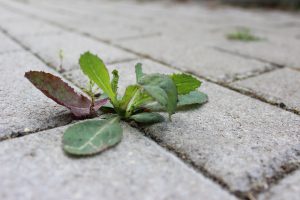
These days, it’s hard not to drift into apocolyptic thinking. With the fires, floods, hurricanes, earthquakes, mud slides, ongoing flirtation with nuclear war, rising visibility of virulent white supremacy, ending of DACA, daily dismantling of federal level protections of civil rights and the environment, and the list goes on, it’s easy to despair. I keep saying to myself and my colleagues that a strong spiritual core is the only thing that keeps me moving! That, and the reality that it’s actually possible to make some progress within my sphere of control.
I’m reminded of two poems …
I am only one
But still I am one.
I cannot do everything
But still I can do something.
And because I cannot do everything
I will not refuse to do the something that I can do.
— Edward Everett Hale (1822-1909) Unitarian Universalist minister
And this word of caution from A Ritual to Read to One Another by William Stafford
… For it is important that awake people be awake,
or a breaking line may discourage them back to sleep;
the signals we give — yes or no, or maybe —
should be clear: the darkness around us is deep.
In spite of the times, I hope you are looking for and encouraged by the acts of resistance, reform, recreating and reimagining that are all around us. There is much we can do to advance justice and sustainability, even in these trying times. Think carefully. Love fully. Work together. Practice community care. While each of us is only one, together, we are the ones we’ve been waiting for.
September 19, 2017
One of the questions that often comes up in our popular workshop, Facilitative Leadership for Social Change goes something like this,
“It’s great that I’m learning all of these practical leadership and facilitation skills, but what happens when I’m not the one leading or facilitating?”
How can we keep things rolling when we aren’t formally in charge and when formal leadership is perhaps not so skillful? My answer: There’s usually some opportunity to lead, ask good questions, and to facilitate from the chair! Read More
September 13, 2017
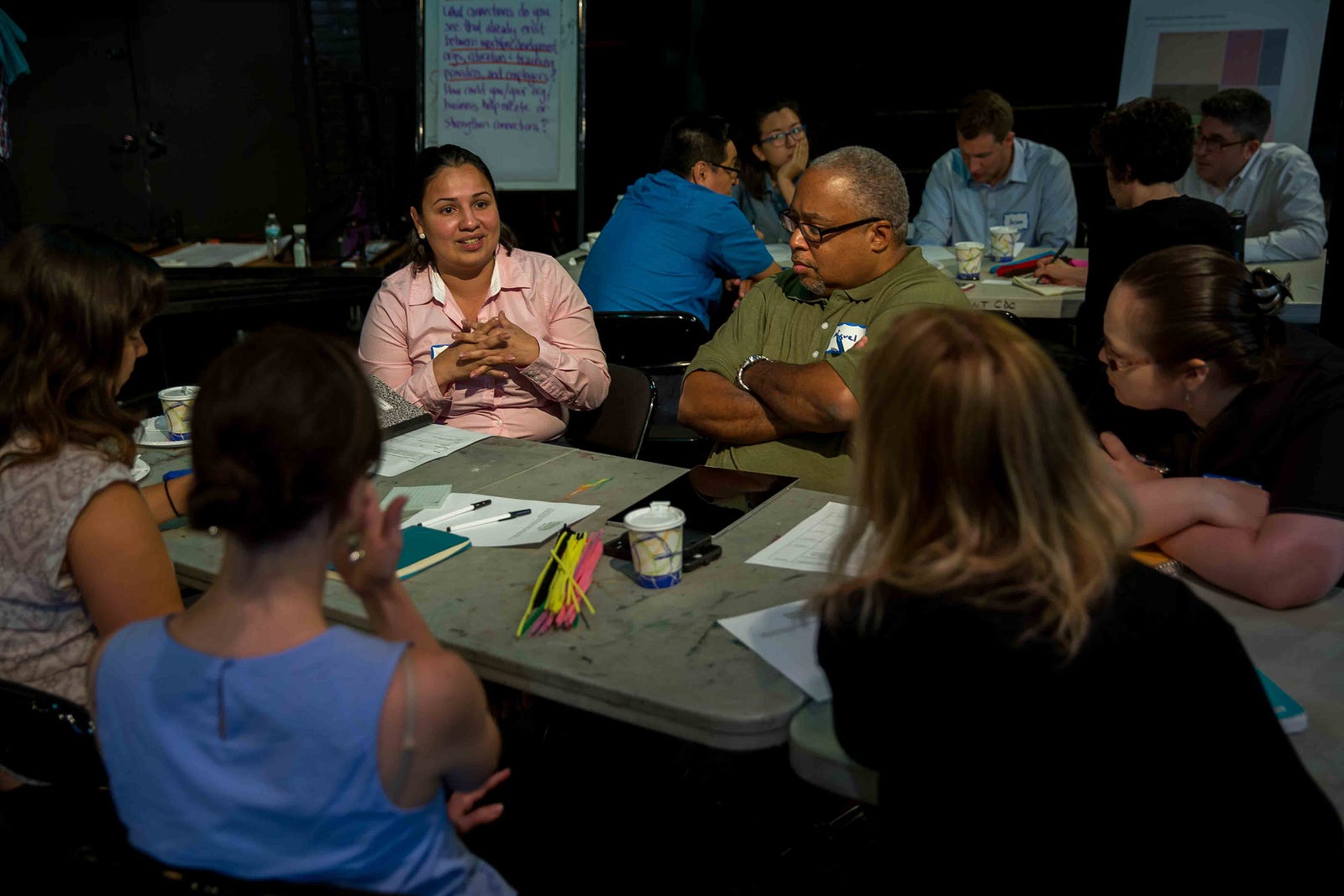
Collaboration Lab participants discuss social and economic resiliency at The Point CDC.
Read More
August 29, 2017
“For a seed to achieve its greatest expression, it must come completely undone. The shell cracks, its insides come out, and everything changes. To someone who doesn’t understand growth, it would look like complete destruction.”
In the late spring, we had an unseasonably sticky stretch of days where I live, and after school one day, my wife and I took our girls to a local swim hole to cool down. As we eased into the cold water, one of our seven-year-old twins clutched desperately to my torso, not yet willing to put more than a toe or foot in. As the sun beat down, I began to feel both the weight of her body and the ebb of my patience, and I managed to negotiate her to a standing position in water that came to her waist. She continued to clutch my arm vice-like with both of her hands.
After another few minutes it was definitely time for me to go under water. But Maddie was unwilling to release me. I continued to encourage her to let go first, to get her head and shoulders wet. Initially totally reluctant, she got to a point where she was in just up to her neck but was still anxiously squeezing my hand. We did a bit of a dance for a few minutes where she would get to the end of my finger tips with her right hand, seemingly ready to take the plunge, and then the same part-anticipatory part-terrorized expression came to her face and she was back against me.
I kept coaxing her, and then let her know that whether she let go or not, I was going under, and if she was still holding on to me, that she would be doing the same. “Okay, okay!” she yelled, stamping her feet and once again got to the tips of my fingers while breathing rapidly. And this time … she let go. She pushed off and immersed her entire body in the water. She came up shrieking but with a big smile on her face, a bit shocked but also more at home in the water, moving around quite gracefully, actually. She splashed me and laughed and then I dived in. A few minutes later she was swimming along next to me.
Read More
August 15, 2017
I love Twitter.
On the heels of the Hunts Point Resiliency Collaboration Lab (about which a blog post is forthcoming) that a team of us from IISC facilitated a couple of weeks ago, I tweeted the following –
“Change the space, change the conversation. Change the conversation, change the possibilities.”
Without getting into all of the details, by shifting what might otherwise might have been a typical meeting through the use of art, music, tactile objects, intentional arrangement of seating, delicious food, robust opportunities for interaction, etc., those in attendance acknowledged that we were able to get to authentic and important conversations that many had been eager to have. And these have opened some opportunities about which people are very excited.
My almost off-handed tweet was picked up and retweeted by a few people, including Nadia von Holzen, who then put together the wonderful graphic above and put it back into the Twittersphere. I love the enhancement and contribution. Thanks, Nadia!
This is another example of what can happen when you “think or work out loud.” In this intricately connected world, you never know who is listening and what gifts they stand poised to bring to your humble offerings.
August 8, 2017
I am saddened to learn that Mila Baker passed away recently. While I did not know her personally, she was a mentor from a distance. A few years ago, I read her book about peer-to-peer leadership and found it both enlightening and validating as I continued my journey to uncover more about the promise of seeing and doing in networked ways.

Mila N. Baker
Mila Baker was a writer, teacher, philanthropist, cross-sector leader and artist. At the time of her passing, she served on the Board of Directors for the Berrett-Koehler Foundation, was a member of the adjunct faculty at Columbia University Teachers College, as well as a Principal Research Investigator at the Institute for Collaborative Workplaces, and Visiting Professor at Kuwait University. The following is a post I wrote after reading her book published in 2014.
I just finished reading Mila Baker’s Peer-to-Peer Leadership: Why the Network is the Leader, which adds to the growing case for more widespread network thinking, foregrounding of human relationships, and shifting traditional conceptions (and myths) of leadership in business and beyond. Baker’s book echoes the spirits of Margaret Wheatley, Clay Shirky, Carol Sanford, Nilofer Merchant, Kevin Kelly, and Harold Jarche, and I appreciate how she couches her writing in the evolving leadership and organizational development literature and thinking.
Read More
August 2, 2017

Photo credit: Ginko biloba leaves by James Field (Jame). Ginko trees are considered endangered even though they are cultivated worldwide, because so few live in the wild. This file is licensed under the Creative Commons Attribution-Share Alike 3.0 Unportedlicense.
I’ve often said that language is difficult, but it’s all (or at least most) of what we have to communicate complex ideas. I can remember when doing “diversity work” was seen as cutting edge, relevant, and powerful. It was an effort to change historic structures of exclusion, to change outcomes for people of color and women who suffered the brunt of racism and sexism. It was a chance to speak truth to power, and it seemed for a while that power was listening. Until it wasn’t. Or, more precisely, until the listeners started to hear “diversity” and think only about “heterogeneity.” With the stroke of a pen checking off boxes, the work was domesticated, watered down, simplified, and downsized into simply getting different faces in the place. And folks who were thinking bigger thoughts had to find new ways to talk and to get others to think and act on inclusion and equity.
I remember in the mid-2000s when I started saying “We don’t do diversity work, but if you want to think about diversity, equity, and inclusion, we might be the right people for you.” Now, I’m afraid, that equity might be running its course. I’m encouraged, on the one hand, by how many more people and organizations are asking questions about equity. And about how the equity conversation focuses on what we want, not what we don’t want. I’m all about the positive vision of life chances fulfilled without barriers based on any aspect of identity. And it’s also clear to me that some of those folks are using the language of equity precisely to avoid talking about racism, sexism, and other -isms that produce and sustain inequities. Somehow “equity” and even “inequities” are more comfortable rolling off the tongue than racism, classism, sexism, or homophobia. I wonder if “equity” as a concept is headed the way of “diversity.”
Still, if we are going to advocate for equity as the superior growth model for our country, as our friends from PolicyLink have so aptly argued, I wonder what language will help to keep our attention focused on dismantling the drivers of inequity in order to increase the odds that we’ll actually achieve something approaching equity. The science surrounding the origins, consequences, and remedies for unconscious bias or implicit association seem to be promising entry points for some people who are reluctant to enter a discussion doorway marked “racism” or “privilege.” And, research and practice around communications and messaging gives us other avenues to pursue. In these days of particularly fraught racial discourse, what are you finding useful in your practice? What are you finding gets in the way?
August 1, 2017
Stevie Johnston from our Belfast, Northern Ireland office reflects on learning from delivering a Training for Trainers in North Carolina.
When we’re teaching Facilitative Leadership for Social Change (FL4SC), we stress that the workshop is made up of leadership practices and – like all things in life (playing the guitar, dancing, listening), if we practice we get better at what we do. The more we use our leadership skills the better leader we become. This fits with our belief that leaders are made not born. Indeed, Malcolm Gladwell in his book ‘Outliers,’ disavows the idea of innate talent and focuses instead on the “10,000-Hour Rule.” His theory is that to achieve world-class expertise in any skill is, to a large extent, a matter of practising for approximately 10,000 hours.
Recently, I had the privilege of working with the leadership development team in the Charlotte Mecklenburg Schools in North Carolina, supporting them to become trainers of IISC’s Facilitative Leadership for Social Change workshop. During the workshop, each of the participants got the opportunity to deliver two of the core training elements. For highly skilled educational leaders such as these, developing and delivering a leadership training piece held no real anxiety. And yet, each of the trainers identified that the delivery of their second training piece was significantly better than their first. As Nicole said, “I was much more relaxed when it came to delivering my next piece. When you have the first delivery behind you, you have much more confidence in how to use the charts whilst keeping the connection with the participants. It means you can concentrate on the materials and the essence of what you are trying to communicate.” When we discussed this as a group, it was clear that performance anxiety can get to us all and that both practice and positive coaching have a real impact on our future performance.
Whilst we may not all reach the giddy heights of being world class, we are presented daily with opportunities to practice facilitative leadership. For example, organising an outing with friends requires collaborative planning and is a great opportunity to think about the actual mental processes we employ when we go about doing something like this. We have to get clear on the types and order of conversations we need to have such as these questions. “Are we looking for the perfect trip out?” “Do we need to think about people’s work schedules first?” “Could we not just grab our gear and hit the road?” We also need to get clear on who is going to make the decision if we can’t arrive at something on which we all agree. This “pathways thinking” about the nature of the conversations we need to have, in what order and how are we going to make the final choice, tends to stop groups from going round in circles and helps them arrive at a decision more readily and with less aggravation.
Similarly, we can employ process thinking when helping a colleague make an important personal decision. Often, we want to rush to tell them what we think they should do: “If I were you, I’d definitely do this.” Or else we will latch on to the first idea they have: “Yes, that seems like a really good idea; I’d go with that one.” In reality, decisions are best made when we generate lots of ideas and talk them through and evaluate the merits of each before choosing the best solution. Sound obvious? It is, and yet often we are not consciously aware of the processes which good decisions entail. So, the next time you’re having coffee with a friend to discuss a decision they have to make, think about how you are going to generate options (open the conversation), evaluate the options (narrow), and choose the best option (close).
Let’s keep on looking for those opportunities to practice and to get feedback and support as we do so. I may not reach the 10,000 hours, but over the course of a lifetime I plan to come close.
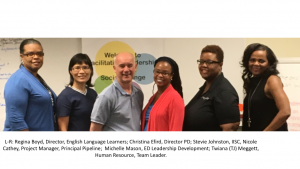
July 25, 2017
“The difficulty we face is that the ecology of the biosphere is at odds with the ecology of our institutions.”
– Nora Bateson
In the past couple of posts, I have referenced Nora Bateson’s book Small Arcs of Larger Circles: Framing Through Other Patterns, a collection of essays, poetry, personal stories and excerpts of talks focused on systems theory and complexity thinking. I just finished the book and have underlined and tweeted a number of provocative lines that resonated and gave me pause (in a good way). Here are a few gems from the book that I continue to contemplate in different contexts:
“The problem with problem-solving is the idea that a solution is an endpoint.”
“Systems theory is struggling inside a system that doesn’t actually accommodate it.”
“We cannot know the systems, but we can know more. We cannot perfect the systems, but we can do better.”
“What does it mean to be healthy in an unhealthy system?”
“No living thing exists in just one context.”
Read More
July 18, 2017
One recent night, my son stomped out of the house, hurt, telling me that I should stop defining who he is and what he can do. My daughter followed after him, asking that I think about what I had done to cause the blow out. I meditated, cooked dinner, and two hours later we were eating a great puttanesca together.
That evening – and other parenting moments – have led me to recognize that my best liberation and change work these days is mothering. While there is so much to write and share about parenting, here I will glean what I can from my children about ways to improve work.
Here are five things I do with or learned from my kids that might work for you as well.
-
Play
Just do it. Be silly, open up new parts of the brain, laugh, release endorphins. Do it at home and do it at work. Brain science tells us that laughter and play opens us and what flows is much more effective than working from worry and constriction. It does not mean that there are not real-life worries and real dangers everywhere—poor health and racism, for starters—but it is an invitation to play along the way. I re-learned how to play from my kids. I invest time in being as goofy with them as possible and bringing some of that spirit of laughter and fun into my work. We work a lot, it should be fun and fun generates new possibilities. What is the work equivalent of running through the fountain or blowing bubbles? What do you do at work to create fun and be creative?

-
Honor who they are and not only what they do or how well they do it
In work settings and movement building efforts we of course need to keep our eye on results. In racial equity work, that focus is particularly important as we have seen how changes in laws do not necessarily lead to changes in heart, nor does understanding lead automatically to reducing disparities. And yet, we know from parenting that honoring who a person is and valuing them for that is so much more important for long term well-being and success than a good grade or accomplishment. How can we keep our eye on the big changes as we honor ourselves and our co-workers for who we are and the spirit and talents we bring and not just what we produce?
-
Be present
Walking down the street, it is often the adults walking with children—holding hands or skipping or watching the trains – who seem most present and look happiest. It is a reminder that of how critical presence is for all of us. At a recent convening, The Confluence sponsored by MAG, someone offered this gem: “less prep, more presence.” Let’s make sure that we bring impeccable presence to our workplaces. Whether at large gatherings, staff or member meetings, or one-on-one conversations, bring your full presence. How do you stay present, planting seeds that flourish in the moment and over the longer term?
-
Show love and caring
While this may be an “of course” in family, it needs to be just as much so in the workplace. At a network gathering last week, I went to the bathroom, tired, after facilitating a challenging session on health equity. I found someone there in tears, having just lost a family member. I was able to show her some tenderness. The next day she reminded me how important the care I offered was for her and, in fact, opened her to learning. These moments, large and small, present themselves daily. What is the workplace equivalent of the schnuggle? Can you find more moments to show love to your co-workers and partners? What might that elicit?
-
I don’t need to be in something with my kids to know how incredible it is for my kids.
While my daughter plans a social justice orientation program for students at her college, I can simply watch her and her peers create and experiment; I can stand aside and watch it blossom. I have to let my kids experiment in the world and experience their ups and downs. I don’t have to help or be in it to know it will be an incredible learning experience. This is a good reminder to allow people to try new things and to flourish and stumble with their work, and learn from it all along the way. How do you practice standing aside?
People in organizations – just like in our families – need this level of tending and love. We all need play, space, and autonomy to create great things. It is a truism that change starts at home. Perhaps it is less clear that home can improve our work. Let’s garner those lessons.
What else can we learn from the kids?
July 18, 2017
(I want to give a BIG shout out to Marsha Boyd for helping to inspire this post with her words and spirit. Thank you, Marsha, for your collegiality, mentoring, and leadership by example!)
For the past couple of weeks, I have been savoring a book by Nora Bateson entitled Small Arcs of Larger Circles: Framing Through Other Patterns. Bateson is a filmmaker, writer and activist, and also the daughter of Gregory Bateson, ground-breaking anthropologist, philosopher, systems thinker, cyberneticist and author of Steps to an Ecology of Mind. Small Arcs of Larger Circles is a mind-stretching and heart-opening amalgamation of essays, poetry, personal stories and excerpts of talks. Throughout Bateson offers a ranging exploration of systems theory and complexity thinking with an invitation to embrace a broader epistemological lens (what people think of as sources of legitimate knowledge) including embodied knowing and aesthetic experience.
In an essay entitled “The Fortune Teller,” Bateson explores the human tendency to stave off consciously or unconsciously anticipated disaster and decline by trying to keep things stable or as they have been. Think the most recent financial crisis. A recent article on the site Evonomics entitled “It Takes a Theory to Beat a Theory” reminds us of the story of former Federal Reserve chairman Alan Greenspan, a champion of unfettered capitalism. Greenspan fought against initiatives to rein in derivatives markets even as there were signs of turbulence and calls to make substantial changes. On October 23, 2008, Greenspan admitted he was wrong, making the following statement to the House Committee on Oversight and Government Reform: “Those of us who have looked to the self- interest of lending institutions to protect shareholders’ equity, myself included, are in a state of shocked disbelief.” But what has significantly changed? Or consider a very recent article about local government efforts in Ventura County, California to site a new fossil fuel plant on a beach starting in 2020 that ignore protests from organized low-income residents concerned about air quality and lack of access to the beaches, and environmental organizations pointing out the real danger stemming from underestimations of sea level rise.
While in some ways understandable (few of us probably like the idea of collapse and chaos), actions taken to preserve a certain kind of order and direction (not to mention power and privilege) can be particularly perverse when they reinforce the very patterns that are leading us down the road to collective ruin. And what more people are beginning to sense is that many social, economic and political patterns that have been established and gotten us to where we are must change for the sake of long-term survival and thriving. Read More

